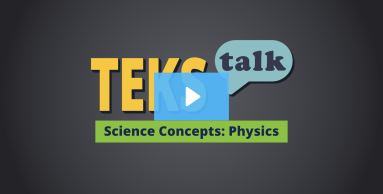- Science
- Grade 9
- Science concepts
PHYS.9.C

Knowledge and Skills Statement
The further explanation is designed to be a resource for educators that helps them better understand the topic their students are learning. Further explanations may be written at a more complex level than would be expected for students at the grade level.
Understanding quantum superposition
It is helpful to know the Copenhagen interpretation. The Copenhagen interpretation is a theory in quantum mechanics that states that a quantum particle exists in all of its possible states at the same time. The theory was first proposed by physicist Niels Bohr in 1920.
The Copenhagen interpretation states that:
- Atomic and subatomic particles sometimes act like particles and sometimes act like waves. This is called “wave-particle duality.”
- Observation is needed to collapse the wave function and see the reality of the state.
- Quantum mechanics provides knowledge of phenomena, but not as pointing to 'really existing objects.'
- The experiment should be described from the perspective of the final observer.
The Copenhagen interpretation does not work for atoms with multiple electrons in the outer shell such as helium atoms.
The density of electrons (in blue/white) from the double-slit (left) to the detection wall (right) is shown below. Each dot on the right corresponds to the impact of one electron on the detection wall. The curve indicates the density of impacts of the electrons on the detection wall.
Understanding wave-particle duality
The diagram below shows an energy-space photograph of light confined on a nanowire. It simultaneously shows both spatial interference (wave) and energy quantization (particle).
Research
Li, Jia-Kun, Kai Sun, Yan Wang, Ze-Yan Hao, Zheng-Hao Liu, Jie Zhou, Xing-Yan Fan, Jing-Ling Chen, Jin-Shi Xu, Chuan-Feng Li, and Guang-Can Guo. "Experimental Demonstration of Separating the Wave‒Particle Duality of a Single Photon with the Quantum Cheshire Cat." Light: Science and Applications 12, no. 18 (2023). https://doi.org/10.1038/s41377-022-01063-5
Summary: In this work, we experimentally separated the wave and particle attributes of a single photon by exploiting the quantum Cheshire cat concept for the first time. Our work provides a new perspective for the in-depth understanding of wave‒particle duality and promotes the application of weak measurements in fundamentals of quantum mechanics.
